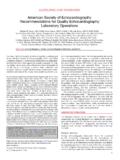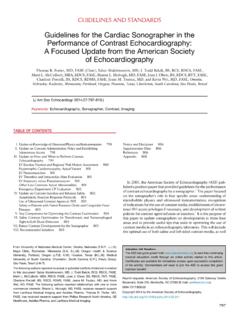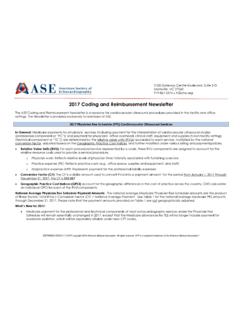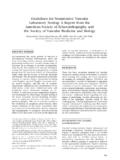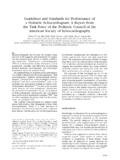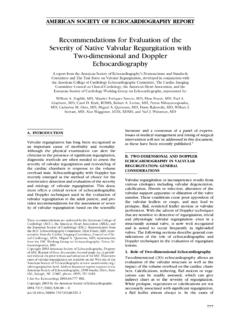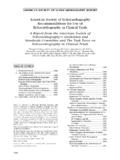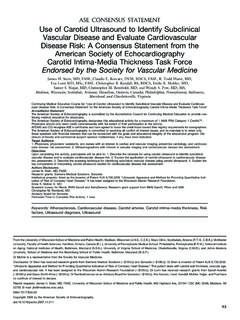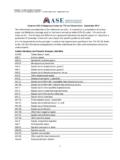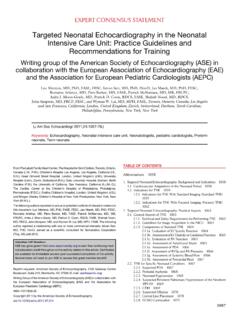Transcription of Recommendations on the Echocardiographic Assessment of ...
1 EACVI/ASE CLINICAL RECOMMENDATIONSR ecommendations on the EchocardiographicAssessment of Aortic Valve stenosis : A FocusedUpdate from the European Association ofCardiovascular Imaging and the American Societyof EchocardiographyHelmut Baumgartner, MD, FESC, (Chair), Judy Hung, MD, FASE, (Co-Chair), Javier Bermejo, MD, PhD,John B. Chambers, MB BChir, FESC, Thor Edvardsen, MD, PhD, FESC, Steven Goldstein, MD, FASE,Patrizio Lancellotti, MD, PhD, FESC, Melissa LeFevre, RDCS, Fletcher Miller Jr., MD, FASE,and Catherine M. Otto, MD, FESC,Muenster, Germany; Boston, Massachusetts; Madrid, Spain; London, UnitedKingdom; Oslo, Norway; Washington, District of Columbia; Li ege, Belgium; Bari, Italy; Durham, North Carolina;Rochester, Minnesota; and Seattle, WashingtonEchocardiography is the key tool for the diagnosis and evaluation of aortic stenosis .
2 Because clinical decision-making is based on the Echocardiographic Assessment of its severity, it is essential that standards areadopted to maintain accuracy and consistency across Echocardiographic laboratories. Detailed recommen-dations for the Echocardiographic Assessment of valve stenosis were published by the European Associationof Echocardiography and the American Society of Echocardiography in 2009. In the meantime, numerous newstudies on aortic stenosis have been published with particular new insights into the difficult subgroup of lowgradient aortic stenosis making an update of Recommendations necessary. The document focuses in partic-ular on the optimization of left ventricular outflow tract Assessment , low flow, low gradient aortic stenosis withpreserved ejection fraction, a new classification of aortic stenosis by gradient, flow and ejection fraction, anda grading algorithm for an integrated and stepwise approach of aortic stenosis Assessment in clinical practice.
3 (J Am Soc Echocardiogr 2017;30:372-92.)Keywords:Aortic stenosis , Echocardiography, Computed tomography, Quantification, Prognostic parametersTABLE OF CONTENTSI ntroduction 373 Aetiologies and Morphologic Assessment 373 Basic Assessment of Severity 375 Recommendations for Standard Clinical Practice 375 Peak Jet Velocity 375 Mean Pressure Gradient 378 Aortic Valve Area 379 Alternative Measures of stenosis Severity 382 Simplified Continuity Equation 382 Velocity Ratio and VTI Ratio (Dimensionless Index) 382 AVA Planimetry 383 Experimental Descriptors of stenosis Severity 383 Advanced Assessment of AS Severity 383 Basic Grading Criteria 383 From the Division of Adult Congenital and Valvular Heart Disease, Department ofCardiovascular Medicine, University Hospital Muenster, Muenster, Germany( ); Division of Cardiology, Massachusetts General Hospital, Boston,Massachusetts ( ); Hospital General Universitario Gregorio Mara~n on, Institutode Investigaci on Sanitaria Gregorio Mara~n on, Universidad Complutense deMadrid and CIBERCV, Madrid, Spain ( ); Guy s and St.
4 Thomas Hospitals,London, UK ( ); Department of Cardiology and Center for CardiologicalInnovation, Oslo University Hospital, Oslo, and University of Oslo, Oslo, Norway( ); Heart Institute, Washington, District of Columbia ( ); Universtiy of Li egeHospital, GIGA Cardiovascular Science, Heart Valve Clinic, Imaging Cardiology,Li ege, Belgium ( ); Gruppo Villa Maria Care and Research, Anthea Hospital,Bari, Italy ( ); Duke University Medical Center, Durham, North Carolina ( );Mayo Clinic, Rochester, Minnesota ( ); and Division of Cardiology, Universityof Washington School of Medicine, Seattle, Washington ( ).This article is being co-published in the European Heart Journal CardiovascularImaging and the Journal of the American Society of Echocardiography.
5 The arti-cles are identical except for minor stylistic and spelling differences in keepingwith each journal s style. Either citation can be used when citing this articleConflict of interest: None requests: American Society of Echocardiography, 2100 Gateway CentreBoulevard, Suite 310, Morrisville, NC 27560 ASE Members:The ASE has gone green! earn free continuingmedical education credit through an online activity related to this are available for immediate access upon successful completionof the activity. Nonmembers will need to join the ASE to access this greatmember benefit!0894-7317/$ The Authors, 2017. This article is being co-published in the European HeartJournal - Cardiovascular Imaging and the Journal of the American Society ofEchocardiography.
6 The articles are identical except for minor stylistic and spellingdifferences in keeping with each journal s style. Either citation can be used whenciting this Considerations of Diffi-cult Subgroups 383 Low Flow, Low Gradient ASwith Reduced Ejection Frac-tion 384 Low Flow, Low Gradient ASwith Preserved Ejection Frac-tion 385 Normal Flow, Low GradientAS with Preserved Ejection Frac-tion 386 New Classification of AS byGradient, Flow, and EjectionFraction 386 Assessment of the LV inAS 386 Conventional Parameters ofLV Function 386 Novel Parameters of LVFunction 387LV Hypertrophy 387 Integrated and StepwiseApproach to Grade ASSeverity 387 High Gradient ASTrack 387 Low Gradient ASTrack 387 Associated Pathologies 389 Aortic Regurgitation 389 Mitral Regurgitation 389 Mitral stenosis 389 Dilatation of the AscendingAorta 389 Arterial Hypertension 389 Prognostic Markers 389 Follow-up Assessment 390 Reviewers 390 INTRODUCTIONA ortic stenosis (AS)
7 Hasbecome the most common pri-mary heart valve disease and animportantcauseofcardiovascularmorbidit y and is the key toolfor the diagnosis and evaluationof AS, and is the primary non-invasive imaging method for ASassessment. Diagnostic cardiaccatheterization is no longer rec-ommended1-3except in rarecases when echocardiography isnon-diagnostic or discrepant with clinical clinical decision-making is based on the echocardiographicassessmentoftheseverity ofAS,itisessentialthatstandardsbeadopted tomaintain accuracy and consistency acrossechocardiographiclabora-tories when assessing and reporting AS. Recommendations for theechocardiographic Assessment of valve stenosis in clinical practicewere published by the European Association of Echocardiographyand the American Society of Echocardiography in aim ofthe 2009 paper was to detail therecommended approach to the echo-cardiographicevaluationofvalvesteno sis,includingrecommendationsfor specific measures of stenosis severity, details of data acquisition andmeasurement, and grading of severity.
8 These 2009 recommendationswere based on the scientific literature and on the consensus of a panelof experts. Since publication of this 2009 document, numerous newstudies on AS have been published, in particular with new insightsinto the difficult subgroup of low gradient AS. Accordingly, a focusedupdate on the Echocardiographic Assessment of AS appeared to be aneeded document and is now provided with this with the 2009 document, this document discusses a number ofproposed methods for evaluation of stenosis severity. On the basis ofan updated comprehensive literature review and expert consensus,these methods were categorized for clinical practice as: Level 1 Recommendation: anappropriate and recommendedmethod for allpatients with aortic stenosis .
9 Level 2 Recommendation: areasonablemethod for clinical use when addi-tional information is needed in selected patients. Level 3 Recommendation: a methodnot recommendedfor routine clinicalpractice although it may be appropriate for research applications and inrare clinical is essential in clinical practice to use an integrative approachwhen grading the severity of AS, combining all Doppler and 2 Ddata as well as clinical presentation, and not relying on one specificmeasurement. Loading conditions influence velocity and pressuregradients; therefore, these parameters vary depending on intercurrentillness of patients with low vs.
10 High cardiac output. In addition, irreg-ular rhythms or tachycardia can make Assessment of AS severity chal-lenging. Ideally, heart rate, rhythm, and blood pressure should bestated in the Echocardiographic report and hemodynamic assessmentshould be performed at heart rates and blood pressures within thenormal range. These guidelines provide Recommendations forrecording and measurement of AS severity using , although accurate quantification of disease severity is anessential step in patient management, clinical decision-making de-pends on several other factors, most importantly, whether or notsymptoms are present. This document is meant to provide echocar-diographic standards and does not make Recommendations for clin-ical management.
